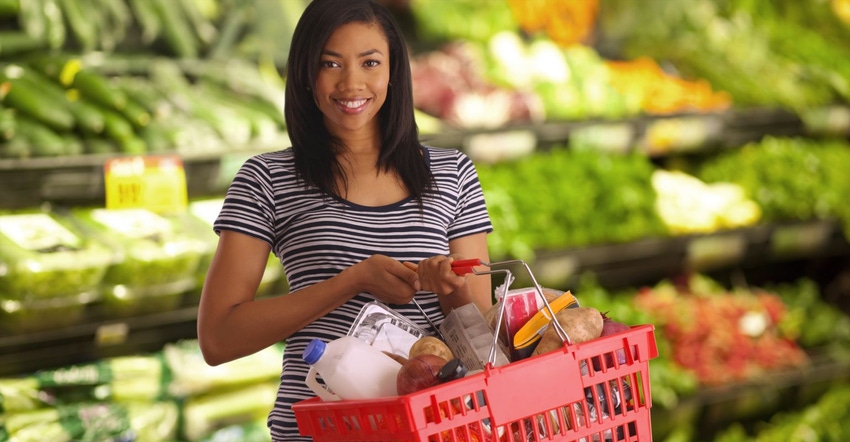Millennials spend more than boomers on food, beverages
Younger Millennials are outspending older generations in food dollars and seeking out products that are sustainable and plant-based, according to the latest IRI Consumer Connect™ survey and IRI’s “Early View 2019: Food and Beverage Trends” report.

According to the Early View 2019: Food and Beverage Trends” report, edible sales increased in January 2019; however, the growth was slower than the industry average and cooled off in February and March. The West (4.1 percent) and Plains (3 percent) regions led the way in edible growth, and the Northeast (1.4 percent) and South Central (1.2 percent) had the slowest growth for the 13 weeks ending March 25, 2018. Storewide department sales trends are rather mixed. Beverage and liquor were top-performing departments in Q1 2019, while the general food and refrigerated departments, which experienced 3.7 percent and 3.2 percent growth in January, declined by 1.5 percent and 1.1 percent, respectively, in March 2019.
Produce and meat posted declines in pounds, placing downward pressure on the whole sector in Q1, while the bakery department posted strong dollar growth driven by price. Perimeter pound growth has slowed compared to a year ago across most sectors, including deli cheese, deli meat, deli prepared, bakery, meat, produce and seafood.
“Younger Millennials have been lulled by the historically low unemployment rates, which is boosting their overall confidence and loosening their wallets,” said Joan Driggs, vice president of Content and Thought Leadership, IRI. “At the other end of the spectrum, many Baby Boomers, retirees and seniors are concerned about their retirement savings due the volatile stock market this year and are watching their expenses more carefully. In recent years, Millennials have been less optimistic than older consumers and were spending less. We are now seeing a role reversal that is impacting spending on edibles across the board.”
Generational spending and saving habits
Younger Millennial spending on food and beverages is clearly outpacing older baby boomers and retirees, who struggled in Q1. In fact, younger Millennials’ edible dollar sales grew by 21.5 percent for March compared to one year ago. Edible dollars sales for retirees and senior is down by 3.8 percent for March compared to one year ago.
Older generations are embracing a wide variety of money-saving tactics including buying private label, trying new, lower-priced brands, visiting multiple retailers, and downloading coupons from retailer/manufacturer website. They also are more likely to buy food and beverage brands other than their preferred brand because they are on sale and buy brands because they have a coupon. However, retirees and seniors won’t scrimp on certain items, with 44 percent regularly purchasing premium quality food and beverage products compared to 38 percent of younger Millennials.
Emerging trends in sustainable and plant-based products
With nearly six in 10 consumers interested in eating less meat, and nearly eight in 10 Millennials eating meat alternatives, it is no secret that plant-based eating is gaining momentum. The rate of consumer acceptance of plant-centric products across the store is increasing rapidly, going from just a handful of categories in 2014 to more than 90 categories, totaling more than $13 billion in cumulative sales in 2018. Products including dish care, facial care and cosmetics are reaching peak household penetration in addition to more obvious products, such as pet food, meat alternatives and cheese.
The need for cleaner and healthier products goes beyond plant-based products, with 78 percent of consumers saying sustainable sourcing of ingredients is an important product attribute. Research conducted by IRI and NYU’s Stern Center for Sustainable Business found that sustainably marketed products delivered 50.1 percent of market growth from 2013 to 2018 while representing 16.6 percent of the CPG market in dollar sales in 2018. Across all categories, sustainably marketed products delivered $113.9 billion in sales in 2018, 29 percent growth compared to 2013, and are expected to grow to $140.5 billion by 2023.
“The latest generational spending habits combined with increased interest in plant-based and sustainable products, opens up an array of new opportunities for CPG marketers,” Driggs said. “To be successful marketers must consider the importance of social media reviews, create fresh, relatable content and be authentic when targeting younger consumers. This doesn’t mean marketers should lose sight of older consumers, who still have the greatest purchasing power, but marketers must be very savvy and develop personalized, targeted marketing campaigns that appeal to the various generations of shoppers.”
About the Author(s)
You May Also Like






.png?width=800&auto=webp&quality=80&disable=upscale)